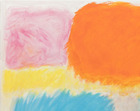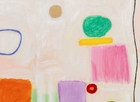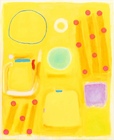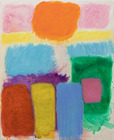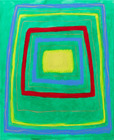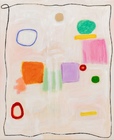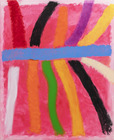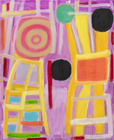It is with great pleasure that The Commercial presents Angela Brennan: Vibing Cosmos, the artist's first exhibition with the gallery. These paintings were commissioned for Brennan’s solo exhibition at the Art Gallery of Ballarat earlier this year, curated by Julie McLaren. The exhibition comprises six great vertical oil paintings, like altarpieces in six parallel universes.
Angela Brennan (b. 1960, l. Naarm/Melbourne) is an artist whose practice over four decades is a thesis in colour and its relationships. She creates exuberant, primordial experiences in paint. While predominantly abstract, her practice often extends to include figuration, portraiture and text. Her paintings, footnoted with external references in titles, text and figurative elements, "build a potent self-image of the artist, reflecting her various interests, beliefs and preferences" (Michael Graf). For art of such unbridled joy, Brennan’s work houses an erudite core. It is sensate, material, intellectual.
—
Her influential rethinking of abstraction and modernism is broad and deep. She activates art history through the present – or our present through art history. Her work has appeared in 55 solo exhibitions in commercial galleries, national and state museum exhibitions and in backyards. She is known for her generous gatherings with peers of varying generations and for the conversations she engages in with younger artists […]
There is something exhilarating about viewing Brennan’s works, like drawing for the first time. Compositions that render forms, not objects, as a relation. A psychological game – three orbs, two rings, slabs of colour, contrails of light. Encountering intellect and love humming with the vibration of colours juxtaposed or, at other times, muddied and mauled, these floating forms envelop, making me suspicious of my own implicit negativity
—Lisa Radford, 'Quantum Colour, Angela Brennan’s Art Gallery of Ballarat Exhibition', The Saturday Paper, April 6-12, 2024
*
To recognise Brennan’s work as inherently linked to what came before is to recognise one of the most critical elements of her practice. It situates her within a camp of soft abstractionists who are interested in growth within cycles as opposed to problems and resolutions. To underscore this point, let us consider Brennan’s enduring preoccupation with the black line. Taking a cursory look through Brennan’s back catalogue, we notice a black, string-like border crop up from time-to-time, painted freehand around the canvas’s edge. Leitmotifs, such as this border, are constant throughout Brennan’s works, even if her style of abstraction has shifted over the decades. In Tête-à-tête & Vis-à-vis the black line appears once more in String theory 2023. In this instance, the line includes a single twist in the top left corner and has been painted with a delicate fineness that threatens to sink into the fleshy pink below or to dissolve into the chalky white overlayed in parts.
—Amelia Winata, 'Tête-à-tête & Vis-à-vis', exhibition text, Art Gallery of Ballarat, 2024
*
A certain pleasure principle prevails in Angela Brennan’s free and abundant painterly practice, manifest in pulsing, billowing abstract paintings which highlight the inherently sensual and ineffable character of aesthetic engagement. Drawn to expansive, expressive colour, Brennan’s paintings give form to thoughts and feelings: fields of colour are defined by an experimental approach to mark-making — bold contours, feathered, scumbled, scrawled — which allow for a variety of sensations and desires to consort and coexist.
Angela Brennan’s early work was celebrated for the ways in which her then somewhat eccentric abstraction loosened up the formalist strictures of late-modernist painting, introducing a feminine subjectivity, playfulness or jouissance into the frame. In her recent work Brennan continues to explore the significance of form, fragment and detail, with reference to the work of medieval painters and Byzantine decorative arts, among other influences. With a penchant for the unorthodox and uncanny, she juxtaposes pattern and decorative motifs to create anachronistic stylistic clashes invoking energy and surprise. Rather than relying on a pre-planned schemata, Brennan’s aesthetic is wholly intuitive; the paint, linen and brushes govern themselves but at the same time connect to a reality beyond the painting.
— Max Delany, ‘Angela Brennan’, in Painting. More Painting, exh. cat. Australian Centre for Contemporary Art, Melbourne, 2016
*
On a stunning yellow and blue warm day in June 2018, I am standing on the steps of the Museo della Ceramica, Caltagirone in eastern Sicily. I am in love with art. I am in love with painting, with ancient ceramic artefacts, votive statues, byzantine mosaics, patterns, and brush-marks; with colour grounds and floating form that detaches from one painting to turn up in another, with other painters’ painting decisions, with their painting unconsciousness, with their performing in and through their work. I am in love with form that untethers itself and floats through artistic eras. A repertoire of visual memories accrues, to unfurl later in my studio, to become material form.
—Louise Angela Brennan, ‘Introduction’, A painter’s encounter with pre-modern artworks as influences for a contemporary studio practice, doctoral thesis, Monash University, Melbourne, 2018














